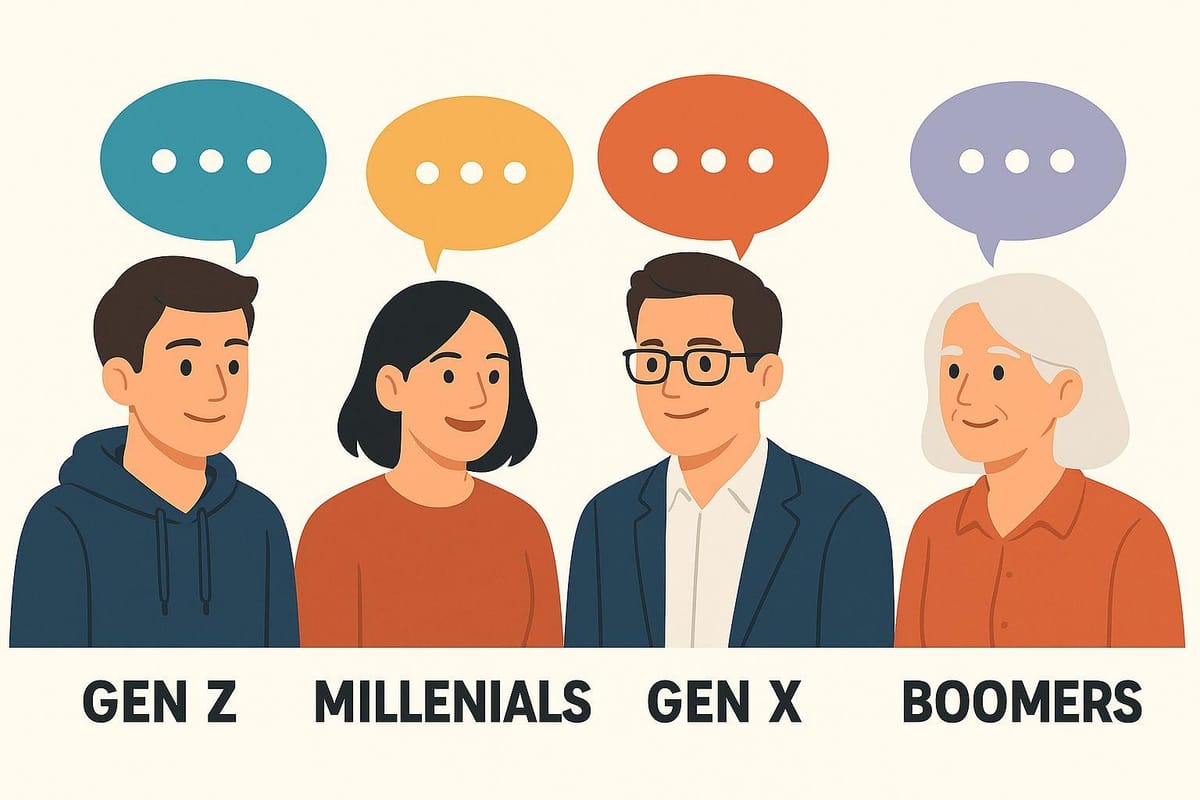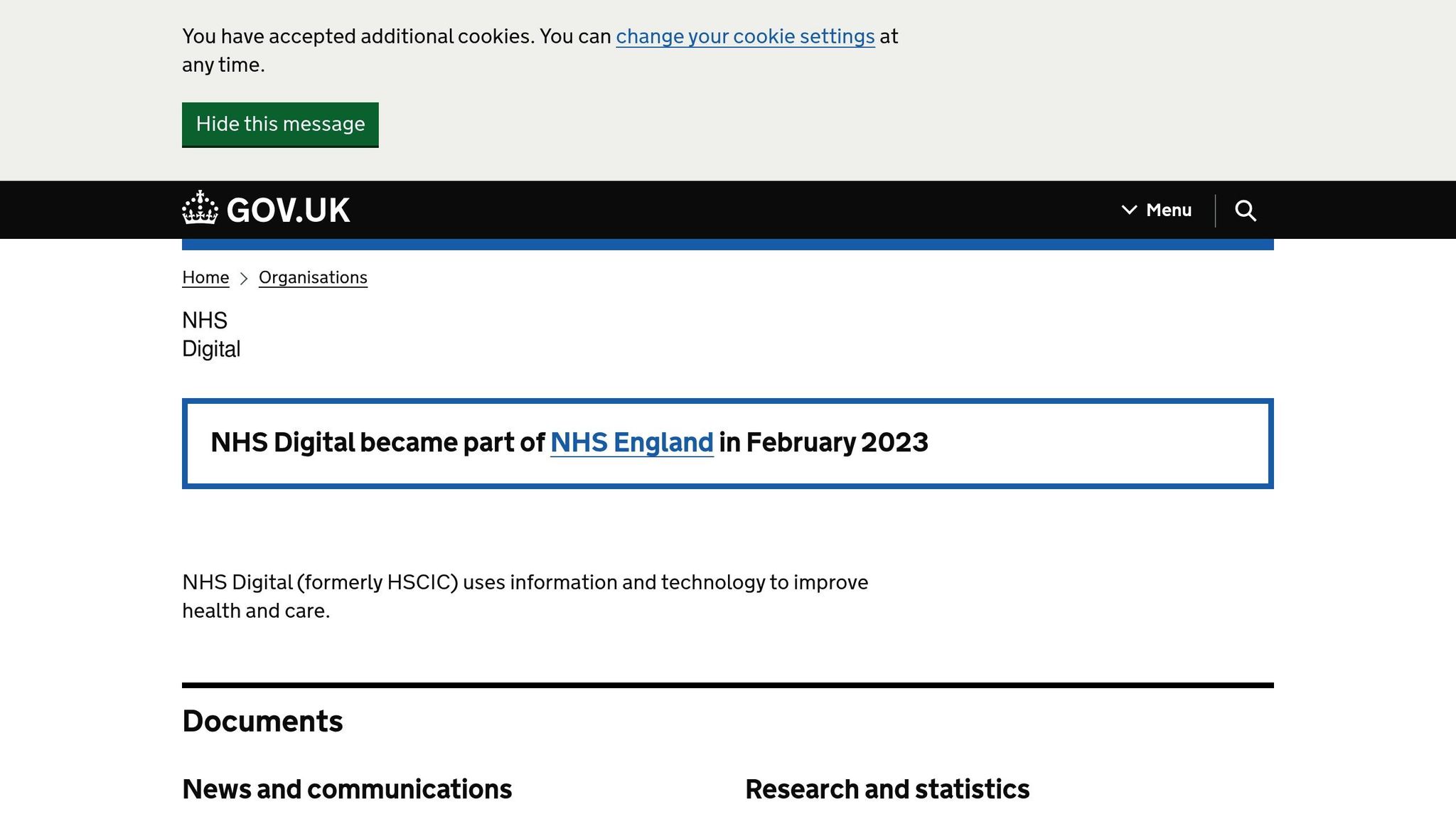The Multi-Generational Workforce - Communicating Effectively Across the Generations
Explore effective communication strategies to bridge the generational divide in today's multi-generational workforce.

How do you lead a team with five generations working together? Start by understanding their communication styles. Each group - from the Silent Generation to Gen Z - has unique preferences shaped by their experiences. Miscommunication can cause trust issues and lower productivity, but bridging these gaps can unlock collaboration and growth.
Key Takeaways:
- Generations at Work: Silent Gen (<5%), Baby Boomers (15%), Gen X (31%), Millennials (36%), Gen Z (18%).
- Communication Styles:
- Silent Gen & Boomers: Formal, structured.
- Gen X: Direct, concise.
- Millennials: Collaborative, transparent.
- Gen Z: Digital-first, fast-paced.
- Challenges: Technology preferences, work-life balance, and communication differences.
- Solutions:
- Use inclusive tools (e.g., intranets, mobile platforms, face-to-face meetings).
- Keep communication clear and jargon-free.
- Encourage feedback and mentoring across generations.
By 2030, Millennials and Gen Z will make up 74% of the workforce. Leaders must embrace diversity by tailoring communication tools, fostering collaboration, and creating environments where every voice is heard.
How Each Generation Communicates
Baby Boomers: Structure and Protocol
Baby Boomers tend to favour a structured and orderly approach when it comes to communication in the workplace. They appreciate formal face-to-face conversations and place a high value on clear protocols. For them, building strong relationships and recognising effort and dedication are fundamental aspects of effective communication.
Gen X: Direct and Results-Focused
Generation X leans towards straightforward and outcome-driven communication. They prefer concise emails and in-person discussions that get straight to the point. Independence in decision-making is a priority for this group, and they appreciate communication that respects their autonomy while focusing on results.
Millennials: Open and Connected
Millennials excel in collaborative environments. They value transparency and thrive on frequent, open interactions. Equally comfortable with digital tools and in-person exchanges, their communication style often reflects a strong desire for purpose and opportunities for personal and professional growth.
Gen Z: Digital-First Communication
For Generation Z, digital platforms are second nature. They favour short, visual, and direct messages, often incorporating abbreviations, emojis, and quick transitions between different communication tools. Their style highlights the importance of adapting to rapid, multi-platform communication to stay connected.
| Generation | Unique Communication Insights |
|---|---|
| Baby Boomers | Prefer traditional protocols and relationship-driven interactions |
| Gen X | Appreciate clear documentation and actionable messages |
| Millennials | Look for purpose and growth through open collaboration |
| Gen Z | Rely on visual, fast-paced, and platform-hopping communication |
Bridge the Generation Gap: Key Steps
Choose the Right Communication Tools
Connecting across generations means finding tools that work for everyone. A well-rounded communication setup might include:
- A user-friendly intranet for centralised updates and resources
- Mobile-friendly platforms for on-the-go accessibility
- Face-to-face meetings to maintain personal connections
- Collaborative tools for instant teamwork and problem-solving
Once the right tools are in place, the next step is to ensure the messages themselves resonate with all age groups.
Keep Messages Clear and Inclusive
With the right tools, the focus should shift to delivering messages that are easy to understand and impactful. Simplicity and accessibility are key here.
| Communication Element | How to Implement |
|---|---|
| Language | Use straightforward, jargon-free language while staying professional |
| Format | Combine visuals and text to cater to different preferences |
| Timing | Share updates on a schedule but offer flexible access |
| Channel Selection | Use multiple platforms to ensure everyone gets the message |
Clear communication opens the door to meaningful conversations, but it’s just as important to create a space where feedback flows both ways.
Create Opportunities for Two-Way Feedback
Once clarity is achieved, fostering feedback is essential to bridging generational divides. Here are some ways to encourage open dialogue:
- Regular Feedback Sessions: Incorporate both in-person and online options to suit everyone’s preferences.
- Cross-Generational Mentoring: Pair colleagues from different generations to exchange insights and improve understanding.
- Communication Surveys: Use surveys in various formats to assess how effective your strategies are and identify areas for improvement.
Success Story: NHS Digital

NHS Digital: Breaking Down Barriers
NHS Digital’s transformation journey offers a powerful example of how to bridge generational communication gaps effectively. This case study highlights the importance of selecting the right tools and encouraging feedback to accommodate diverse communication preferences.
Their approach combined smart technology with a significant cultural shift, guided by the '70/30 Rule' - 70% focus on culture and 30% on technology.
Here’s how they made it happen:
Digital Heroes Programme
This initiative trained 2,200 employees to become digital champions, creating a support network that spanned all age groups. The results were striking: digital tool adoption among staff aged over 55 jumped from 23% to 72%.
Multi-Channel Communication Strategy
Recognising the varied needs of different generations, NHS Digital adopted a multi-channel approach. They introduced mobile-first apps with video consultation features, kept traditional phone support, used AI tools to convert text into voice memos, and provided printed guides for complex tasks. This ensured everyone had access to communication tools that suited them.
Cross-Generational Mentoring
By pairing younger, tech-savvy employees with more experienced colleagues, NHS Digital created a two-way mentoring system. This exchange of skills and knowledge not only built stronger relationships but also contributed to a 30% decrease in staff turnover.
In just 18 months, these efforts led to impressive results: 89% staff engagement in digital training, a 40% drop in communication-related errors, and a 65% quicker policy adoption rate.
To ensure these changes were long-lasting, NHS Digital implemented annual digital fluency assessments and formed cross-generational product teams. Their success shows that bridging the generational gap doesn’t mean forcing everyone onto a single platform. Instead, it’s about creating an environment where different communication styles can coexist and flourish.
NHS Digital’s story provides practical steps for leaders looking to address generational divides effectively.
Conclusion: Next Steps for Leaders
Five Key Actions to Take
Reflecting on the communication strategies and examples shared earlier, here are five practical steps leaders can take to improve team collaboration and achieve measurable outcomes, as demonstrated by NHS Digital.
Understand Individual Communication Styles
Develop profiles for your team members that outline their preferred ways of communicating. By tailoring your approach to individual preferences, you demonstrate respect for unique working styles.
Encourage Generational Collaboration
Intentionally bring together team members from different generations on critical projects. Pair this with structured reverse mentoring programmes, where younger, tech-savvy employees share their expertise with seasoned colleagues, and vice versa. This approach fosters both informal and formal knowledge sharing.
Set Clear Communication Standards
Provide a straightforward guide that outlines communication expectations. This might include:
- Defined business hours for responding to messages
- Differentiation between urgent and non-urgent communication channels
- Protocols for various meeting formats (virtual, in-person, hybrid)
- Standards for documenting and sharing information
Once these guidelines are established, focus on creating opportunities for mutual learning across age groups.
Promote Reciprocal Learning
Encourage every generation to learn from one another. This approach not only strengthens inclusivity but also enhances overall team communication, which can directly influence organisational success.
Track and Adjust Regularly
Keep an eye on how your team engages with different communication tools and methods. Analyse trends in participation, response times, and the quality of feedback. Use this data to fine-tune your strategies, ensuring that no one feels left out or overlooked.
Communication and the Multigenerational Workforce
FAQs
How can leaders adapt their communication to meet the needs of a multi-generational workforce?
To connect effectively across different generations, leaders need to adopt a flexible approach. This means using a variety of communication methods - like email, video calls, instant messaging, and face-to-face discussions - to suit individual preferences. A rigid, one-size-fits-all strategy just won’t cut it.
One great way to bridge generational gaps is by encouraging knowledge-sharing. Pairing team members from different age groups through mentoring or reverse mentoring can go a long way. These partnerships not only help align communication styles but also promote mutual respect and understanding.
Equally important is creating an environment where stereotypes are questioned and open conversations are welcomed. By prioritising respect, adaptability, and clear communication, organisations can build stronger connections within a diverse team.
How can we encourage effective mentoring and collaboration between different generations in the workplace?
To encourage meaningful cross-generational mentoring and teamwork, the first step is to create an environment rooted in respect. Promote open dialogue where employees of all ages feel heard and valued. Programmes like traditional mentoring and reverse mentoring can be particularly effective. These initiatives allow younger staff to benefit from the wisdom of seasoned professionals while providing an opportunity for older colleagues to gain fresh perspectives from younger generations.
Organising team-building activities that mix age groups can also help forge stronger connections and ease generational divides. Additionally, offering diversity and inclusion training can deepen employees' understanding of generational differences, fostering empathy and collaboration. These strategies not only strengthen team dynamics but also contribute to the overall success of the organisation.
How can organisations evaluate the effectiveness of their communication strategies across generations?
The easiest way to figure out what’s effective - and what’s not - is to simply ask. Get direct feedback from employees about their preferred ways of communicating and engaging. This approach clears up any guesswork and provides actionable insights to enhance communication across different age groups.
Look for trends in the feedback. Are particular methods working better for specific generations? Use this information to adjust your approach, making sure it meets the needs of everyone, no matter their age.
